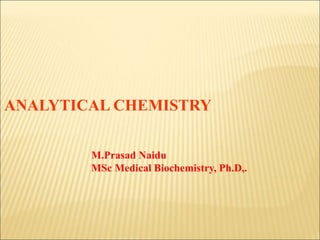Analytical-Chemistry.6487261.powerpoint.pptx
•Download as PPTX, PDF•
0 likes•3 views
analytical chemistry helps physicians diagnose and understand diseases and analyze biological samples such as enzymes, bacteria, and blood.
Report
Share
Report
Share

Recommended
Recommended
More Related Content
Similar to Analytical-Chemistry.6487261.powerpoint.pptx
Similar to Analytical-Chemistry.6487261.powerpoint.pptx (20)
Colorimeter and spectrophotometer, Mass Spectrometer

Colorimeter and spectrophotometer, Mass Spectrometer
Liquid chromatography–mass spectrometry (LC-MS) BY P. RAVISANKAR

Liquid chromatography–mass spectrometry (LC-MS) BY P. RAVISANKAR
analytical techniques for estimation of organic compounds

analytical techniques for estimation of organic compounds
Detector used in hplc chromatogrphy by pradeep jaiswal msc part1 mithibai col...

Detector used in hplc chromatogrphy by pradeep jaiswal msc part1 mithibai col...
DETECTORS USED IN GAS CHROMATOGRAPHY AND HPLC BY P.RAVISANKAR.

DETECTORS USED IN GAS CHROMATOGRAPHY AND HPLC BY P.RAVISANKAR.
Recently uploaded
Mehran University Newsletter is a Quarterly Publication from Public Relations OfficeMehran University Newsletter Vol-X, Issue-I, 2024

Mehran University Newsletter Vol-X, Issue-I, 2024Mehran University of Engineering & Technology, Jamshoro
Recently uploaded (20)
Vishram Singh - Textbook of Anatomy Upper Limb and Thorax.. Volume 1 (1).pdf

Vishram Singh - Textbook of Anatomy Upper Limb and Thorax.. Volume 1 (1).pdf
ICT role in 21st century education and it's challenges.

ICT role in 21st century education and it's challenges.
Micro-Scholarship, What it is, How can it help me.pdf

Micro-Scholarship, What it is, How can it help me.pdf
ICT Role in 21st Century Education & its Challenges.pptx

ICT Role in 21st Century Education & its Challenges.pptx
Basic Civil Engineering first year Notes- Chapter 4 Building.pptx

Basic Civil Engineering first year Notes- Chapter 4 Building.pptx
Food safety_Challenges food safety laboratories_.pdf

Food safety_Challenges food safety laboratories_.pdf
Mixin Classes in Odoo 17 How to Extend Models Using Mixin Classes

Mixin Classes in Odoo 17 How to Extend Models Using Mixin Classes
Analytical-Chemistry.6487261.powerpoint.pptx
- 1. ANALYTICAL CHEMISTRY M.Prasad Naidu MSc Medical Biochemistry, Ph.D,.
- 2. Classical Methods of Analysis Early years of chemistry •Separation of analytes by precipitation, extraction, or distillation. •Qualitative analysis by reaction of analytes with reagents that yielded products that could be recognized by their colors, boiling or melting points, solubilities, optical activities, or refractive indexes. •Quantitative analysis by gravimetric or by titrimetric techniques.
- 3. Instrumental Methods •Measurement of physical properties of analytes - such as conductivity, electrode potential, light absorption or emission, mass-to-charge ratio, and fluorescence-began to be employed for quantitative analysis of inorganic, organic, and biochemical analytes •Efficient chromatographic separation techniques are used for the separation of components of complex mixtures. •Instrumental Methods of analysis (collective name for newer methods for separation and determination of chemical species.)
- 6. Electroanalytical Chemistry •A group of quantitative analytical methods that are based upon the electrical properties (electrical response) of a solution of the analyte (chemical system) when it is made part of an electrochemical cell. •Chemical System: Electrolyte; measuring electrical circute; Elcrodes
- 7. USES OF ELECTROANALYTICAL CHEMISTRY Electroanalytical techniques are capable of producing very low detection limits. Electroanalytical techniques can provide a lot of characterization information about electrochemically addressable systems. Stoichiometry and rate of charge transfer. Rate of mass transfer. Extent of adsorption or chemisorption. Rates and equilibrium constants for chemical reactions.
- 8. ADVANTAGES COMPARED TO OTHER METHODS •Inexpensive •Used for ionic species not total concentration •Responds to ionic activity rather than concentration •Ion selective electrodes and developing of the measuring devices in voltammetry made wider spread of the methods
- 9. REVIEW OF FUNDAMENTAL TERMINOLOGY Electrochemistry - study of redox processes at interfaces Heterogeneous So two reactions occurring: oxidation reduction
- 10. • For the reaction, O + ne- R • Oxidation: R O + ne- – loss of electrons by R • Reduction: O + ne- R – gain of electrons by O
- 11. OXIDANTS AND REDUCTANTS Oxidant = oxidizing agent reactant which oxidizes another reactant and which is itself reduced Reductant = reducing agent reactant which reduces another reactant and which is itself oxidized
- 12. ELECTROCHEMICAL CELLS CONSISTS OF TWO CONDUCTORS (CALLED ELECTRODES) EACH IMMERSED IN A SUITABLE ELECTROLYTE SOLUTION. FOR ELECTRICITY TO FLOW: THE ELECTRODES MUST BE CONNECTED EXTERNALLY BY MEANS OF A (METAL) CONDUCTOR. THE TWO ELECTROLYTE SOLUTIONS ARE IN CONTACT TO PERMIT MOVEMENT OF IONS FROM ONE TO THE OTHER.
- 13. Interesting, right? This is just a sneak preview of the full presentation. We hope you like it! To see the rest of it, just click here to view it in full on PowerShow.com. Then, if you’d like, you can also log in to PowerShow.com to download the entire presentation for free.